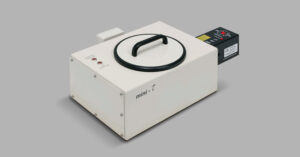Fluorescence lifetime standards are useful for checking the calibration of fluorescence lifetime spectrometers and accounting for the possible wavelength dependent response of detectors. An effective fluorescence lifetime standard should have a monoexponential fluorescence decay that is independent of the choice of excitation and emission wavelength.
The recommended reference for fluorescence lifetime standards is Anal. Chem. 79 2137-2149 (2007) which was a multinational collaboration involving nine research institutions. The fluorescence lifetimes of 20 fluorophore and solvent combinations were independently measured by each research institution using time and frequency domain lifetime spectrometers to give a set of 20 accurately known fluorescence lifetimes. The mean lifetimes reported by the study and the excitation and emission wavelengths used are given in the table below.
| SYSTEM | ||
|---|---|---|
| Raman Polarisation | Optional | Polarisation kit available, fully computer-controlled |
| Internal Calibration | Wavelength calibration standard (Neon) Raman shift standard (Silicon) Sensitivity validation standard (Silicon) Automated laser alignment |
|
| Microscope System | Functionality Optional Objective(s) Sample Viewing Sample Stage Optional | Full upright microscope with brightfield and darkfield illuminator Polarisation, Differential Interference Contrast (DIC) capability and fluorescence imaging 10x and 100x objective included as standard; up to 5 can be included Trinocular eyepiece, embedded CMOS video camera, second video camera optional XY manual stage XYZ motorised stage (75 mm x 50 mm XY), confocal Raman mapping Temperature-controlled sample stages available |
| Software | Ramacle® Operating System Functionality Optional | Comprehensive all-in-one, intuitive software package Windows® Data acquisition, spectrograph control, graphical display, data processing Chemometric, spectral library packages – KnowItAllTM |
| Laser Safety | Without Laser Enclosure With Laser Enclosure | Class 3B Class 1 |
| Dimensions | W x D x H † Weight † | 600 mm x 800 mm x 600 mm † 63 kg * depending on grating, laser and CCD selection † without laser enclosure |
Mean lifetimes of fluorescence standards and their excitation and emission ranges. Data obtained from Anal. Chem. 79 2137-2149 (2007).1 The samples were measured at 20 °C and the solutions degassed using freeze pump thaw or inert gas bubbling.
[a] Compound Names
DPA: 9,10-diphenylanthracene
NATA: N-acetyl-L-tryptophanamide
POPOP:1,4-bis(5-phenyloxazol-2-yl)benzene
PPO: 2,5-diphenyloxazole
SPA: N-(3-sulfopropyl)acridinium
[b] The quoted lifetime is the mean value across the different measuring institutions and the error is the sample standard deviation. The solutions were degassed prior to measurement and since oxygen is a fluorescence quencher measurement of non-degassed solutions will result in shorter lifetimes than reported here.

